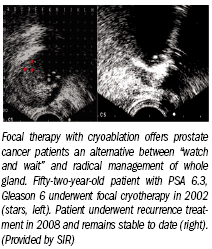Cryoablation bests surgery for treating prostate cancer
More than a decade's worth of data suggest cryoablation can treat localized malignancies within the prostate more safely and effectively than do standard treatment approaches generally applied to the whole gland.
More than a decade's worth of data suggest cryoablation can treat localized malignancies within the prostate more safely and effectively than do standard treatment approaches generally applied to the whole gland. Study findings presented at the 2009 Society of Interventional Radiology meeting in San Diego also run against "watch and wait" conventional wisdom.
The U.S. Department of Health and Human Services advised last August that men 75 and older should not be screened for prostate cancer and that younger men should take a second look at prostate-specific antigen tests and biopsies. Because the available evidence indicated that most men with prostate cancer were likely to die of other causes, the agency also recommended a "watchful waiting" approach to cancers detected by screening.

Many patients refuse to go along with such advice and still prefer radical treatments such as radiotherapy and prostatectomy. These patients should not have to swing to extremes, however, and could instead choose the middle ground offered by focal cryotherapy, said principal investigator Dr. Gary Onik, director of the Center for Safer Prostate Cancer Therapy in Orlando, FL.
"What we have found is that [by] using a focal therapy instead of treating the whole gland, we can markedly reduce the complications associated with prostate cancer treatment," Onik said in an interview with Diagnostic Imaging.
Onik and colleagues assessed 120 men who underwent ultrasound-guided focal cryoablation. Patients were followed up for an average of almost four years (range, one to 12 years), including PSA measurements every three months for two years and every six months after that. Although more than 70% of those patients were at mid- to high risk of recurrence, 112 (93%) remained disease free.
Only 7% of patients had their cancer recur at a different site in the gland. They were retreated with cryotherapy.
Nearly nine out of every 10 patients treated retained sexual function, while all of those who did not have previous prostate surgery remained continent.
"We have found that even in the high-risk patients, doing focal therapy appears to be almost 40% better than prostatectomy when compared with historical controls. And that's amazing," he said.
About 20% of patients who undergo radical prostatectomy are likely to suffer recurrence because of positive margins left behind after surgery. Cryotherapy, in contrast, provides for a virtually 100% rate of local control because it can be performed repeatedly if necessary, Onik said.
"Patients are going to hear about this now. And their doctors are going to have to decide whether this is something that they want to try and use for whatever class of patients they think it's proper for," he said.
Emerging AI Algorithm Shows Promise for Abbreviated Breast MRI in Multicenter Study
April 25th 2025An artificial intelligence algorithm for dynamic contrast-enhanced breast MRI offered a 93.9 percent AUC for breast cancer detection, and a 92.3 percent sensitivity in BI-RADS 3 cases, according to new research presented at the Society for Breast Imaging (SBI) conference.
The Reading Room Podcast: Current Perspectives on the Updated Appropriate Use Criteria for Brain PET
March 18th 2025In a new podcast, Satoshi Minoshima, M.D., Ph.D., and James Williams, Ph.D., share their insights on the recently updated appropriate use criteria for amyloid PET and tau PET in patients with mild cognitive impairment.
Can Abbreviated Breast MRI Have an Impact in Assessing Post-Neoadjuvant Chemotherapy Response?
April 24th 2025New research presented at the Society for Breast Imaging (SBI) conference suggests that abbreviated MRI is comparable to full MRI in assessing pathologic complete response to neoadjuvant chemotherapy for breast cancer.
Clarius Mobile Health Unveils Anterior Knee Feature for Handheld Ultrasound
April 23rd 2025The T-Mode Anterior Knee feature reportedly offers a combination of automated segmentation and real-time conversion of grayscale ultrasound images into color-coded visuals that bolster understanding for novice ultrasound users.